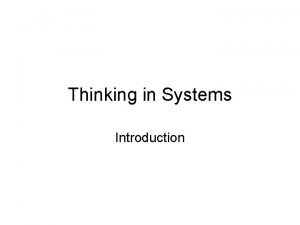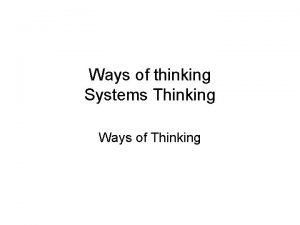Thinking in Systems Systems Thinking The only way













- Slides: 13

Thinking in Systems

Systems Thinking • The only way to fully understand why a complex problem occurs and persists is to understand the part in relation to the whole (O'Connor & Mc. Dermott, The Art of Systems Thinking: Essential Skills for Creativity and Problem. Solving) • Traditional scientific approach = isolating small parts of the system • Systems thinking = taking many interactions into account

Systems thinking is needed for problems that are: • Complex problems that involve helping many actors see the "big picture" and not just their part of it • Recurring problems or those that have been made worse by past attempts to fix them • Issues where an action affects (or is affected by) the environment surrounding the issue, either the natural environment or the competitive environment • Problems whose solutions are not obvious http: //www. thinking. net/Systems_Thinking/Intro_to_ST/intro_to_st. html

Example: Obesity

Societal policies and processes influencing the population prevalence of obesity INTERNATIONAL FACTORS NATIONAL/ REGIONAL Transport Globalization of markets Urbanization Health COMMUNITY LOCALITY Public Transport Public Safety Health Care Development Social security Media & Culture Media programs & advertising Education Media Food & Nutrition National perspective Sanitation System Manufactured/ Imported Food Agriculture/ Gardens/ Local markets WORK/ SCHOOL/ HOME INDIVIDUAL POPULATION Leisure Activity/ Facilities Labor Energy Expenditure Infections Worksite Food & Activity Family & Home Food intake : Nutrient density S I T Y O % P OBESE R EOR V A UNDER LWT E N E School Food & Activity Modified from Ritenbaugh C, Kumanyika S, Morabia A, Jeffery R, Antipathies V. IOTF website 1999: http: //www. iotf. org


Diane T. Finegood, Thomas D. N. Merth and Harry Rutter Implications of the Foresight Obesity System Map for Solutions to Childhood Obesity. . Obesity (2010) 18, S 13–S 16. doi: 10. 1038/oby. 2009. 426

Systems Analysis Examples (Leischow et al. Am J Prev Med. 2008) Concept Map System Dynamics Modeling Social Network Analysis

Many Forms of System “Maps” Environmental Risk Factors Mixed Income Housing Demographic Risk Factors Social Networks Food Access: 1 Physical 2 Financial 3 Nutritional 4 Cultural Food Security

GETTING EQUITY ADVOCACY RESULTS (GEAR) # http: //www. policylink. org/site/c. lk. IXLb. MNJr. E/b. 8360755/k. 4160/GETTING_EQUITY_ADVOCACY_RESULTS. htm? msource=newtool

Healthy People 2020

Ecological Framework for Influences on What People Eat

Today’s Work 1. List – Ways in which public health nutrition can help to reach HP 2020 goals 2. Analyze one nutrition problem that is related to both healthy food access and HP goals. • • Draw a picture of the system that influences that problem. Indicate at least 4 potential places in the system where public health might make a difference.
 Leave only footprints take only photos
Leave only footprints take only photos What's a frequency table
What's a frequency table Perbedaan one way dan two way anova
Perbedaan one way dan two way anova Threaded binary tree definition
Threaded binary tree definition Perbedaan one way anova dan two way anova
Perbedaan one way anova dan two way anova Anova test
Anova test One way anova vs two way anova
One way anova vs two way anova Contoh soal analisis varians
Contoh soal analisis varians Conventional software
Conventional software This way that way forwards backwards over the irish sea
This way that way forwards backwards over the irish sea Talk this way
Talk this way Critical thinking in society
Critical thinking in society A way of thinking
A way of thinking An economic way of thinking
An economic way of thinking























